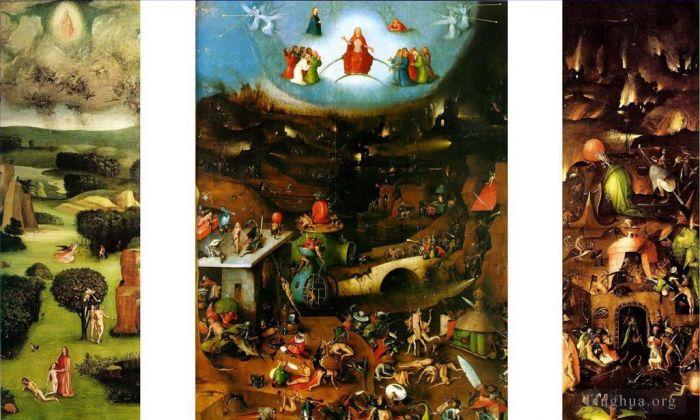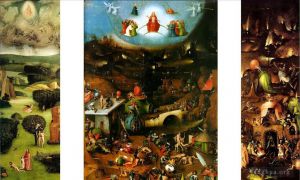The Last Judgment
Hieronymus Bosch
- Price: Price on Request
- Art Type: Oil Painting
- Size:
- English Comments: 0
- International Comments: 0
- Creating Date:
- Introduction and Works of Hieronymus Bosch >>
Keywords:
Judgment
Work Overview
- The Last Judgment
Artist Hieronymus Bosch
Year c. 1482
Type Oil-on-wood triptych
163 x 128 cm (central panel), 167 x 60 cm (each wing)
Location Academy of Fine Arts, Vienna
The Last Judgment is a triptych by Hieronymus Bosch, created after 1482.
The triptych currently resides at the Academy of Fine Arts in Vienna, Austria. The outside of the shutters panel are painted in grisaille on panel, while the inside shutters and the center panel are painted in oil. The left and right panels measure 167.7 x 60 cm and the center panel measures 164 x 127 cm. It is not to be confused with either a fragmented piece of art by Bosch under the same title (now at Munich), or another full painting by Bosch, possibly by a painter in his workshop.[1]
The left panel shows the Garden of Eden, at the top God is shown seated in Heaven while the Rebel Angels are cast out of Heaven and transformed into insects. At the foot of the panel, God creates Eve from the rib of Adam. In the midground Eve is tempted by the Serpent, while the couple are finally seen being chased by the Angel into the dark forest, in the central panel where Jesus judges the souls while surrounded by the Saints. The right panel shows a hellscape, where the wicked are punished.
The oldest mention of the painting is in a 1659 inventory of Archduke Leopold Wilhelm of Austria's collection, as by "Hieronimo Bosz". In the late 18th century, the work was acquired by count Lambert-Spritzenstein, from whom it later went to the current location. In the 17th-18th centuries, the triptych has been widely repainted and has lost part of the colors[citation needed].
Some art historians[2] identified this work as that acquired by Philip I of Castile in 1504, while others deny this. Dendrochronologic analysis proved that the painting was executed not before 1482[2] There is copy of the work, attributed to Lucas Cranach the Elder, in the Gemäldegalerie of Berlin.
The painting's composition has similarities with the Haywain Triptych or the Garden of Earthly Delights: both also show the Garden of Eden in the left panel and the Hell at right. The central panel depicts a Last Judgement, in a more obscure atmosphere than the Hell one.
Shutters
Like in other contemporary Flemish triptychs, the shutters are externally painted in grisaille, depicting two saints. At left is St. James in pilgrimage within a wicked land with a hung man (perhaps a reference to some episode in the Golden Legend) ; at right is instead St. Bavo, the patron of Flanders, donating to the poor with his hawk on his left wrist.
One of the characters in the latter panel, the old woman with a child, appears in a drawing attributed to Bosch, now in a San Francisco private collection.[2]
Detail of the left panel.
Left panel
The left panel depicts the Garden of Eden of the biblical history, as a green landscape in the lower three-quarters. In the upper section Bosch portrayed God sitting on his throne, surrounded by a luminous halo.[2] Around him is a cloudy sky, with angels fighting rebellious angels who are turning into devils as they fall.
Below are, reading from the bottom, God creating Eve from Adam's rib, with Adam sleeping at her feet; the Serpent tempting Eve and the tree of the knowledge of good and evil; and, finally, Adam and Eve expelled from the Garden by an angel, who holds a sword, into a dark forest.[2]
Central panel
The central painting depicts a Last Judgement, basing on John's Book of Revelation. Above is Christ as a judge, surrounded by the Virgin Mary, John the Evangelist and the apostles. The celestial zone, painted in a bright blue, contrasts with the rest of the panel, which is occupied by a dark brownish punishment of the Damned, while the Blessed occupy only a small portion.
The central Last Judgement.
The punishments come from monstrous creatures of Hell: the damned are burned, speared, impaled, hung from butcher hooks, forced to eat impure food (the Gluttonous), or subjects to cogs of bizarre machines. This scene has strong similarities with the right panel in Bosch's Garden at the Museo del Prado.
Right panel
Thematically, the hell at right is not different from the Last Judgement.[3] Satan, in the center, receives the damned souls. The torture scenes continue in this panel, within a dark landscape dominated by flames and devilish figures.
Triptych by Hieronymus Bosch. The left wing tells the story of Adam and Eve: the creation of man, the eating of the apple and the expulsion from Paradise.
The center panel shows the Last Judgment, a popular medieval subject. Seated in heaven, Jesus decides who will go to Hell and who will enter Heaven. The earth is on fire and strange creatures capture the remaining sinners.
The right wing shows Hell, destination of the doomed.
The central panel of the triptych represents the Last Judgment and the Seven Deadly Sins. The interior view of the left wing depicts the Fall of the Rebel Angels, Creation of Eve, Fall of Man and Expulsion, while the interior view of the right wing shows Hell and the Prince of Darkness.
The inclusion of the Fall of Adam and Eve in a representation of the Last Judgment is unusual; the other two panels of the Vienna triptych depart even more from traditional iconography. Generally Heaven was allotted the chief role in the eschatological drama. As in the altarpiece by Roger van der Weyden, it is the act of judgment which is stressed; the judged are relegated to positions of secondary importance, and the felicity of the saved is described as fully as the pains of the lost. In Bosch's version, however, the divine court appears small and insignificant at the top of the central panel, and very few souls are numbered among the elect. The majority of mankind has been engulfed in the universal cataclysm which rages throughout the deep, murky landscape below.
This vast panoramic nightmare represents the earth in her final death throes, destroyed not by water as Dürer and Leonardo were to envision it, but by the fire foretold in a thirteenth-century hymn, the sombre Dies Irae: "Day of Wrath, that day when the world dissolves in glowing ashes". Bosch was probably also influenced by the account of the last days given in the Revelation of St John, a book which enjoyed renewed popularity in the late fifteenth century, when it was illustrated by Dürer in his famous Apocalypse woodcuts of 1497-98. The wide valley dominating the central panel may represent the Valley of Jehoshaphat, which, on the basis of several Old Testament references (Joel 4:2,12), was traditionally thought to be the site of the Last Judgment, with the walls of the earthly Jerusalem blazing in the background. In any event, earth has become indistinguishable from Hell, depicted on the right wing, out of which the army of Satan swarms to attack the damned; the eternity of torment has begun.
The Hell scene in the Prado Tabletop had paired off each punishment with one of the Deadly Sins. In the Last Judgment it would be difficult to identify the punishments with specific sins. The avaricious are boiled in the great cauldron just visible beneath one of the buildings in the central panel. Around the corner, a fat glutton is forced to drink from a barrel held by two devils; the source of his dubious refreshment can be seen squatting in the window overhead. The lascivious woman on the roof above suffers the attentions of a lizard-like monster slithering across her loins, while being serenaded by two musical demons. On the cliffs to the right, across the river, blacksmith-devils hammer other victims on anvils, and one is being shod like a horse; these unfortunate souls are guilty of the sin of anger.
- Copyright Statement:
All the reproduction of any forms about this work unauthorized by Singing Palette including images, texts and so on will be deemed to be violating the Copyright Laws.
To cite this webpage, please link back here.
- >> English Comments
- >> Chinese Comments
- >> French Comments
- >> German Comments
- >>Report
- Adoration of the magi 1511
- The Seven Deadly Sins moral
- Adoration of the Magimoral
- Christ carrying the cross 1
- The carrying of the cross christ and st veronica
- The Path of Life outer wings of a triptych moral
- The fall of the rebel angels 1504
- Crowned with thorns 1500
- The adoration of the magi 1511
- The cure of folly
- The temptation of st anthony 1516
- The conjuror
- Ascent of the blessed 1504
- Group of victims
- Allegory of gluttony and lust 1500
- Saint christopher
- Adoration of the magi
- Paradise and Hell left and right panels of a triptych moral
- Adoration of the child
- The seven deadly sins and the four last things 1485
- Christ Carrying the Cross moral
- The Haywain Triptych
- The ascent into the empyrean or highest heaven
- Saint john the evangelist on patmos 1485
- Adoration of the magi 1516
- The concert in the egg 1480
- Death and the miser 1516
- Temptation of St Anthony left wing of the triptych moral
- Epiphany
- Adoration of the Magi closed moral
- The temptation of st anthony 1511
- The Ship of Foolsmoral
- Hell 1504
- The Cure of Folly moral
- The temptation of st anthony 1512
- Temptation of St Anthony central panel of the triptych moral
- St jerome praying 1500
- The temptation of st anthony 1514
- Triptych of temptation of st anthony 1502
- St Peter with the Donor moral
- Garden of Earthly Delights outer wings of the triptych moral
- St Agnes with the Donor moral
- St john the baptist in meditation 1499
- Hell fall of the damned 1504
- Triptych the temptation of st anthony 1516
- Crucifixion with a donor 1485
- The Last Judgment
- Christ carrying the cross 1490
- Hermit saints triptych left panel
- Death and the Miser moral
- The Garden of Earthly Delights
- Temptation of st anthony 1
- Temptation of st anthony 1506
- Adoration of the magi 1512
- This is a human ecce homo
- The carrying of the cross 1480
- The temptation of st anthony 1513









 Singing Palette
Singing Palette